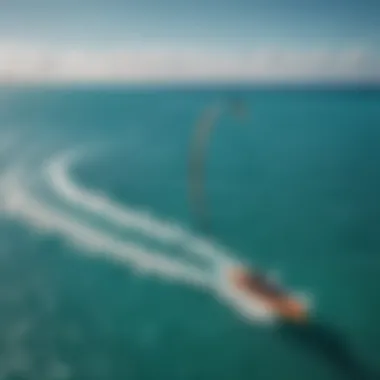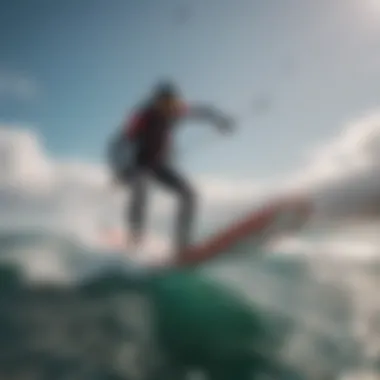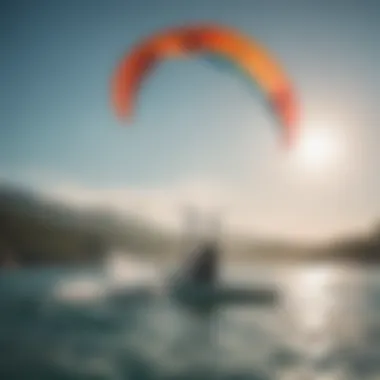Unveiling the World of Kite Foiling: Your Ultimate Guide to Thrilling Water Adventures


Equipment Reviews
Kite foiling enthusiasts are constantly on the lookout for cutting-edge equipment to enhance their experience on the water. In the realm of kites, a myriad of models have surfaced, each boasting unique features and performance capabilities. From delta-shaped kites to hybrid designs, the market offers a plethora of options to cater to every rider's preference. These kites come in various sizes, ranging from small for strong winds to larger sizes suitable for lighter breezes. Additionally, materials used in kite construction play a crucial role in durability and performance, with options like single to double ripstop nylon fabrics. Renowned brands such as Cabrinha, Naish, and Slingshot dominate the market, setting the benchmark for innovation and quality.
When it comes to kiteboarding boards, riders have a choice between versatile twintips and specialized directional boards. Twintips, known for their bidirectional design, provide optimal maneuverability and ease of use for riders of all levels. On the other hand, directional boards cater to advanced riders seeking enhanced performance and control in challenging conditions. The design and construction of these boards significantly impact riding style, with features like rocker profiles, concave bottoms, and carbon reinforcements influencing responsiveness and agility on the water.
Delving into accessories, kiteboarders must equip themselves with essential gear to ensure a safe and enjoyable session. Harnesses play a pivotal role in distributing the rider's weight and minimizing strain during maneuvers, with options such as waist and seat harnesses offering varying levels of support. Quality lines are essential for reliable control of the kite, with different line lengths suitable for diverse riding styles. A dependable pump is indispensable for inflating kites swiftly, while safety gear like helmets, impact vests, and safety knives are vital for rider protection on the water.
Travel Destinations
As globetrotting kitesurfers seek new horizons, popular spots around the world continue to entice with their idyllic settings and optimal wind conditions. Destinations like Tarifa in Spain, Maui in Hawaii, and Brazil's Ceará coast stand out as meccas for kitesurfing enthusiasts, offering consistent winds, crystal-clear waters, and vibrant local cultures. Riders can immerse themselves in these world-class locations, benefiting from well-established amenities, kite schools, and accommodation options to suit every preference.
For adventurers seeking off-the-beaten-path experiences, underrated kitesurfing spots hold untold treasures waiting to be discovered. Remote gems like Dakhla in Western Sahara, Kalpitiya in Sri Lanka, and Langebaan in South Africa offer unspoiled nature, secluded beaches, and uncrowded waters for a serene kiteboarding escapade. Exploring these hidden paradises allows riders to connect with nature on a deeper level, away from the hustle and bustle of mainstream tourist spots.
Techniques and Tutorials
Mastering the art of kite foiling requires a nuanced understanding of fundamental techniques and advanced maneuvers. Beginners venturing into the world of kitesurfing embark on a journey of discovery, learning the basics of launching the kite, riding with control, executing smooth turns, and safely landing back on the water. Step-by-step tutorials guide novice riders through each stage, emphasizing safety, correct kite handling, and gradual skill progression to build confidence and proficiency.
For seasoned riders seeking to push their limits, advanced skills take kite foiling to new heights of excitement and skill mastery. Advanced maneuvers like jumps, tricks, wave riding, and freestyle techniques challenge riders to harness the power of the wind and waves with precision and finesse. Detailed instructions break down complex maneuvers into manageable steps, focusing on technique, timing, and spatial awareness to execute each move flawlessly and showcase the rider's prowess on the water.
Safety Guidelines
Amidst the thrill of kite foiling, prioritizing safety is paramount to ensure a secure and enjoyable experience on the water. Understanding weather conditions is crucial for assessing wind strength, current direction, tide changes, and potential weather patterns that may impact kitesurfing safety. Riders must stay informed and vigilant, monitoring the environment for signs of changing conditions and adjusting their riding plans accordingly to mitigate risks.
In emergencies, having clear protocols and rescue strategies in place can mean the difference between a close call and a serious incident. Essential safety measures such as self-rescue techniques, buddy systems, and communication protocols equip riders to handle common mishaps like tangled lines, lost boards, or sudden wind shifts effectively. Regular equipment maintenance is key to preventing malfunctions and accidents, with routine checks, repairs, and gear inspections safeguarding riders against unforeseen issues that may jeopardize their safety and well-being on the water.
Introduction to Kite Foiling
Kite foiling, a cutting-edge water sport that seamlessly blends kiteboarding with hydrofoil technology, offers enthusiasts a thrilling experience on the water. In this comprehensive guide, we will delve deep into the world of kite foiling, unraveling its intricacies and highlighting key techniques for beginners and experts alike.
What is Kite Foiling?
Definition and Concept
Kite foiling revolutionizes traditional kiteboarding by incorporating a hydrofoil under the board. This innovative design lifts the board above the surface, minimizing drag and allowing for smoother rides even in light wind conditions. The hydrofoil's lift enables riders to glide effortlessly above the water, offering a sensation akin to flying. While mastering kite foiling requires practice, the unique concept attracts thrill-seekers looking to elevate their water sports experience.
Evolution of Kite Foiling


The evolution of kite foiling traces back to pioneering individuals who sought to push the boundaries of water sports. From crude early prototypes to the sleek and efficient foils of today, this technology has undergone significant advancements. Improved designs have enhanced stability and maneuverability, making kite foiling accessible to a wider range of enthusiasts. The evolution of kite foiling reflects a convergence of innovation and expertise, culminating in an exhilarating water sport experience.
Benefits of Kite Foiling
Speed and Efficiency
One of the primary benefits of kite foiling is its exceptional speed and efficiency. The hydrofoil's design reduces water resistance, allowing riders to achieve impressive speeds with minimal effort. Whether racing across the water or gracefully carving turns, the speed and efficiency of kite foiling offer an unparalleled adrenaline rush for enthusiasts seeking a heart-pounding experience.
Enhanced Maneuverability
Kite foiling also boasts enhanced maneuverability, thanks to the hydrofoil system that elevates the board. This increased maneuverability allows riders to execute sharp turns, intricate maneuvers, and seamless transitions with precision and control. The ability to navigate diverse water conditions and terrain with ease makes kite foiling a dynamic and exciting water sport that challenges riders to hone their skills and push their limits.
Gear Required for Kite Foiling
Hydrofoil Setup
Central to kite foiling is the hydrofoil setup, comprising a foil mast, fuselage, and wings that lift the board above the water. The hydrofoil's aerodynamic design and adjustable components enable riders to customize their riding experience based on conditions and skill level. A properly configured hydrofoil setup is essential for stability, control, and performance on the water.
Kiteboarding Equipment
In addition to the hydrofoil setup, kiteboarding equipment such as kites, boards, harnesses, and safety gear are indispensable for kite foiling. High-performance kites designed for foiling, specialized foil boards with reinforced construction, and ergonomic harnesses that ensure rider comfort play crucial roles in enhancing the kite foiling experience. Selecting the right kiteboarding equipment tailored to individual preferences and riding style is paramount for a safe and enjoyable session on the water.
Getting Started with Kite Foiling
Kite foiling is an exhilarating water sport that requires a solid foundation in its basics to ensure a safe and fulfilling experience on the water. In this section, we will delve into the fundamental aspects of getting started with kite foiling, outlining essential elements like body positioning, water start techniques, safety precautions, and selecting the right kite foiling spot. These key topics lay the groundwork for beginners and serve as a refresher for seasoned kite foilers.
Learning the Basics
Body Positioning
Understanding the correct body positioning is paramount in kite foiling. Maintaining proper posture and weight distribution is crucial for achieving optimal balance and control over the board and foil. By keeping your body aligned with the kite and board, you can enhance stability and maneuverability. The unique characteristic of body positioning lies in its direct influence on the rider's ability to harness wind power efficiently, making it a popular choice among kite foiling enthusiasts. While mastering body positioning can be challenging, its benefits in maneuvering through varying wind conditions and executing advanced tricks make it a valuable skill to develop.
Water Start Techniques
Mastering water start techniques is essential for smoothly transitioning from a stationary position to gliding on the water's surface. Implementing the correct technique involves skillfully positioning the kite to generate enough power for lift-off while maintaining control over the foil. The key characteristic of water start techniques is their role in initiating forward motion and achieving sufficient speed for foiling. This approach is favored for its efficiency in propelling riders into foiling positions and overcoming water resistance. Although mastering water start techniques requires practice and coordination, the advantage lies in its ability to facilitate a seamless start to each kite foiling session.
Safety Precautions
Weather Conditions


Considering weather conditions is crucial for ensuring a safe and enjoyable kite foiling experience. Being mindful of factors like wind speed, direction, and potential changes in weather patterns is essential in preventing accidents and mishaps on the water. The key characteristic of weather conditions lies in their influence on kite handling and foil control. Being aware of meteorological cues and their impact on kite foiling activities is a prudent choice for mitigating risks and maximizing safety. While weather conditions can add an element of unpredictability, staying informed and prepared can help kite foilers navigate challenging situations effectively.
Emergency Procedures
Having a clear understanding of emergency procedures is paramount in prioritizing rider safety and well-being. Being familiar with protocols for self-rescue, signaling for assistance, and responding to unexpected events can make a significant difference in emergency situations. The key characteristic of emergency procedures lies in their ability to expedite response times and minimize potential hazards. Following established safety guidelines and continuously honing emergency skills can instill confidence and readiness in facing unforeseen challenges. Despite the importance of emergency preparedness, acknowledging its necessity can reinforce a culture of safety and responsibility within the kite foiling community.
Choosing the Right Kite Foiling Spot
Factors to Consider
Selecting the right kite foiling spot involves evaluating various factors like wind conditions, water depth, obstacles, and accessibility. Each factor plays a crucial role in determining the suitability of a location for kite foiling activities. The key characteristic of factors to consider lies in their direct impact on kite handling, foil performance, and overall safety. By assessing these factors diligently, riders can identify ideal spots that cater to their skill level and preferences. While the process of choosing the right spot requires careful consideration and planning, the advantages of a well-suited location include enhanced foiling experiences and minimized risks of accidents or gear damage.
Popular Locations
Exploring popular kite foiling locations provides riders with diverse settings and conditions to enhance their foiling skills and enjoyment. These spots are favored for their consistent wind patterns, ideal water conditions, and vibrant foiling communities. The key characteristic of popular locations lies in their reputation for offering exceptional foiling experiences and opportunities for connecting with like-minded enthusiasts. Whether seeking challenging waves or tranquil lagoons, popular kite foiling locations cater to a wide range of preferences and skill levels. While each spot may present its unique advantages and challenges, the diverse landscapes and atmospheres contribute to the allure of kite foiling as a global water sport.
Mastering Kite Foiling Techniques
In the realm of kite foiling, mastering the techniques is essential to elevate one's proficiency on the water. This section delves deep into the intricate skills and strategies required to excel in kite foiling. From foiling transitions to advanced maneuvers, mastering these techniques can unlock a world of possibilities and exhilarating experiences for kite foilers.
Foiling Transitions
Tacking and Gybing
Tacking and gybing are fundamental maneuvers in kite foiling that play a crucial role in navigating the water effectively. Tacking involves turning the kite and board through the wind, while gybing is the process of changing direction downwind. These maneuvers are essential for maintaining speed, controlling the foil, and executing smooth transitions on the water. Understanding the nuances of tacking and gybing can significantly enhance a foiler's abilities, allowing them to harness the wind's power efficiently.
Foot Changing
Foot changing is a technique that involves shifting one's stance on the board while in motion. This maneuver is vital in kite foiling for adjusting balance, controlling speed, and executing various tricks and turns. By mastering foot changing, foilers can adapt to changing wind conditions, optimize their riding position, and enhance their overall performance on the water. The ability to change feet seamlessly while foiling opens up a world of creative possibilities and challenges for riders.
Riding Upwind Efficiently
Riding upwind efficiently is a skill that separates novice foilers from seasoned professionals. This section explores the importance of trimming the foil and optimizing body position for upwind riding in kite foiling. Trimming the foil involves adjusting the angle of attack to maximize lift and minimize drag, allowing foilers to sail closer to the wind and achieve superior upwind performance. Additionally, maintaining the correct body position while riding upwind is crucial for stability, speed, and control. By honing these skills, foilers can conquer challenging conditions and navigate the water with precision and grace.
Maintenance and Care Tips for Kite Foiling Equipment
Maintenance and care are vital aspects when engaging in kite foiling to ensure the longevity and performance of your equipment. Proper maintenance not only prolongs the life of your gear but also enhances your safety on the water. In this section, we will delve into essential tips for maintaining your kite foiling equipment to maximize your riding experience.
Hydrofoil Maintenance


Proper upkeep of your hydrofoil is crucial to ensure optimal performance and safety during your kite foiling sessions. Hydrofoil maintenance involves two key components: cleaning and storage, and checking for wear and tear.
Cleaning and Storage
Keeping your hydrofoil clean and storing it properly are fundamental to preventing corrosion and extending its lifespan. By carefully rinsing off saltwater and storing the foil in a dry place, you can prevent damage and maintain its efficiency for future rides.
Checking for Wear and Tear
Regularly inspecting your hydrofoil for any signs of wear and tear is essential for identifying potential issues before they escalate. Look out for scratches, dents, or loose components that may affect the foil's performance. By addressing these issues promptly, you can ensure a safe and smooth kite foiling experience.
Kite Care
Apart from hydrofoil maintenance, caring for your kite is equally crucial to ensure its longevity and performance on the water. Paying attention to details such as inspecting lines and bridles, and proper packing and transport can significantly impact your kite's durability and efficiency.
Inspecting Lines and Bridles
Checking the integrity of your kite's lines and bridles is essential for safe and effective flying. Frayed lines or damaged bridles can compromise the kite's stability and control, posing a risk during your sessions. Regular inspections and timely replacements are key to maintaining your kite in top condition.
Packing and Transport
Properly packing and transporting your kite is vital to prevent damage during storage or transit. Securely rolling and storing your kite in a dry bag, along with its accessories, minimizes the risk of tears or punctures. Additionally, handling the kite with care during transportation ensures that it remains intact and ready for your next exhilarating kite foiling adventure.
Exploring the Thrilling World of Kite Foiling Competitions
Exploring the Thrilling World of Kite Foiling Competitions is a pivotal section in this comprehensive guide on kite foiling. Kite foiling competitions are the epitome of skill, precision, and adrenaline in the world of water sports. Engaging in these competitions not only tests the limits of athletes but also pushes the boundaries of what is achievable in kite foiling. By exploring the competitive aspect of kite foiling, enthusiasts can gain a deeper understanding of the sport's nuances and challenges. Understanding the competitive landscape is crucial for those looking to elevate their kite foiling skills and potentially participate in competitions themselves.
Types of Kite Foiling Events
Formula Kite Racing
Formula Kite Racing stands out as a cornerstone of competitive kite foiling. This specific event showcases the speed, agility, and technical prowess of kite foilers. With a focus on pure performance and efficiency, Formula Kite Racing demands utmost precision from participants. The key characteristic of Formula Kite Racing revolves around its emphasis on speed and strategy. Athletes harness the power of the wind and the innovative technology of kite foiling equipment to reach unparalleled velocities on the water. The unique feature of Formula Kite Racing lies in the strategic planning required, as competitors navigate the racecourse with calculated moves and split-second decision-making. This event offers a thrilling experience for both participants and spectators, setting it apart as a compelling choice for this guide.
Hydrofoil Pro Tour
The Hydrofoil Pro Tour represents the pinnacle of kite foiling competition on a global scale. This event brings together top-tier athletes from around the world to compete in a series of challenging races. The key characteristic of the Hydrofoil Pro Tour is its diverse locations and formidable courses that test participants' skills in varying conditions. It is a beneficial choice for this guide due to its ability to showcase the multifaceted nature of kite foiling and the athletes' adaptability to different environments. The unique feature of the Hydrofoil Pro Tour lies in its ability to attract a broad audience and foster international camaraderie among kite foiling enthusiasts. While the event provides a platform for showcasing talent and innovation, it also presents challenges such as travel logistics and intense competition.
Tips for Success in Competitions
Fitness and Endurance
Fitness and Endurance play a crucial role in attaining success in kite foiling competitions. The demanding nature of competitive kite foiling requires athletes to maintain peak physical condition and endurance levels. The key characteristic of focusing on fitness and endurance is its direct correlation to improved performance and sustained energy during races. Athletes must invest time and effort into training regimens that enhance their strength, stamina, and agility to excel in competitions. The unique feature of prioritizing fitness and endurance is the holistic approach it brings to kite foiling, encompassing both physical and mental preparation for the challenges that lie ahead. While advantageous for enhancing performance, the commitment to fitness and endurance also necessitates dedication and perseverance.
Race Strategy
Race Strategy serves as a fundamental component of achieving success in kite foiling competitions. Developing a meticulous and adaptable race strategy is essential for navigating complex racecourses and outmaneuvering opponents. The key characteristic of effective race strategy is its ability to optimize speed, efficiency, and decision-making under pressure. Athletes must analyze wind patterns, competitor positions, and tactical opportunities to make strategic moves that give them a competitive edge. The unique feature of race strategy lies in its dynamic nature, requiring constant adjustment and responsiveness to changing race conditions. While advantageous for securing victories, meticulous race strategy also involves risks and uncertainties that challenge athletes' strategic thinking and adaptability.







